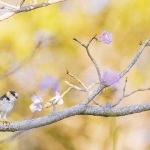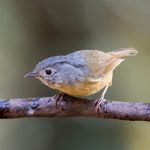The Killdeer is a wide-ranging plover. It breeds across much of North America, is present year-round in the Caribbean, northern Central America, and the west coast of northern South America, and in winter is found across the rest of Central America. Their insistent calls help explain their scientific name, Charadrius vociferus, and are an easily recognizable sound to most birders in the Americas. They are cosmopolitan, nesting even in urban areas, but also in golf courses and parking lots. Essentially, they need flat, open land without tall vegetation in order to feel comfortable nesting. Beyond that they don’t seem to need much.
This ability to nest even in close proximity to humans is a trait I got to take advantage of way back when I first started writing on 10,000 Birds. A co-worker who was having serious landscaping done on her property involving heavy machinery was pleased to let me know that some Killdeer were nesting next to her driveway and invited me out to take some pictures. The birds had grown so used to people and bulldozers that they allowed incredibly close approach and I returned a couple of times to photograph the nest.
Killdeer on nest
Killdeer eggs
One day while we were at work my coworker received a phone call letting her know that the eggs had started to hatch. We headed over after work and I had the great pleasure of photographing a Killfawn just a couple of hours after it hatched.
Killfawn shortly after hatching
Killdeer nestling
Only exquisite timing allowed me to get photographs of a young Killdeer still in the nest scrape because they are precocial, meaning that when they hatch they are ready to get up and about and live their lives instead of spending days or weeks helpless and being fed by adults – a great advantage for a bird that nests on the ground in wide-open spaces. By the next day, when I returned, the entire Killdeer family had vacated the premises. Great for the family but not so great for a birder who wanted pictures of Killfawns running around in the grass.
Fortunately, I found some Killfawns at Jones Beach a couple of years ago and, using my car as a blind, managed to get a couple of shots before they hunkered down in taller grass out of sight.
Killfawn
fledgling Killdeer
Killdeer fledgling in the flowers
The nice thing about these fuzzy little bundles of cuteness is that they grow up to become adult Killdeer, a pretty cute bird even as an adult. How can you not like these graceful and charming plovers?
adult Killdeer
Charadrius vociferus
•••
 Baby Bird Week is our celebration of the young, the cute, the adorable, the twee. We certainly spend enough time on adult birds here on 10,000 Birds so we figured it would only make sense to fawn over the fuzzy bundles of fluff that grow up to become the objects of our fascination. Whether you seek out waterfowl, songbirds, or seabirds we will have baby birds to match your obsession.
Baby Bird Week is our celebration of the young, the cute, the adorable, the twee. We certainly spend enough time on adult birds here on 10,000 Birds so we figured it would only make sense to fawn over the fuzzy bundles of fluff that grow up to become the objects of our fascination. Whether you seek out waterfowl, songbirds, or seabirds we will have baby birds to match your obsession.
Baby Bird Week will run from 15-21 July, Sunday until Saturday. Make sure to check back every day or even multiple times a day to keep up with all the baby bird goodness!
•••




















Redguga would have liked Killfawns. I have to ask, is that an actual term? If not, we should campaign to make it so.
@Simon: It depends on what you mean by an actual term. In the scientific literature? No. But among birders in general? Yes.
@Corey: Wonderful pictures! When I was starting to get into birding a few years ago, a killdeer nest right outside my window at work sealed the deal. Watching the puffy hatchlings toddle around was adorbs beyond belief. But man, are those newborns noisy!
I have only seen one of these guys in Ecuador. Nice you have them there from the beginning.
Just beautiful photos of the fledglings with wildflowers! I’ve never been close enough to see the red eye-ring, so didn’t even know they had one until seeing your photos. Thank you!
Saw a Killdeer next to the parking lot at Bluffers Park Marina outside Toronto. Didn’t realise that the came this far north.